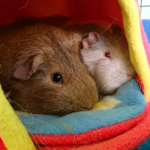This week, we will be discussing the importance of desexing guinea pigs! Many people are often unaware that it is possible to desex guinea pigs, and that there are a number of health benefits to doing this at a younger age.
Did you know that female guinea pigs can become pregnant even as young as 4 weeks old?! This makes it very important to be sure what gender guinea pigs you are acquiring, to avoid unexpected pregnancies! Apart from preventing unplanned pregnancies, desexing your guinea pig can have other health benefits too! Having the procedure performed at a dedicated exotics vet minimises the risks of any complications, and ensures your family member gets the best possible care
Non-desexed male guinea pigs can be housed with other male guinea pigs, however, they do not always get along and they will sometimes give other guinea pigs unwanted attention! This can lead to fighting, and bite wounds can be serious. They can also develop testicular tumours, though these are not common. The most common problem seen in non-desexed male guinea pigs is the accumulation of faeces in the anal vestibule, which often becomes abnormally large in older male guinea pigs. Desexed males are much less likely to develop this problem.
Male guinea pigs are castrated by removing each testicle individually through a separate incisions in each scrotum or through a single abdominal incision. There are some important differences compared to dog/cat castrations. For example it is important that the inguinal canal and skin is closed to prevent intestines herniating out from the abdomen if approached scrotally! These patients also lose body heat very quickly due to their small size. Here you can see a temperature probe that remains in place throughout surgery to ensure the patient stays warm; and a heated blanket underneath the patient that is inflated with warm air throughout the procedure.
Did you know that 80% of female guinea pigs over the age of 1 year old develop ovarian cysts? These cysts can sometimes be very large (several centimetres wide) and cause discomfort by putting pressure on other important structures in the abdomen. These cysts can cause hair loss and crusting of the teats. More seriously, they can also be associated with changes of the uterus, which are sometimes cancerous.
Young, healthy female guinea pigs are usually speyed by removing only the ovaries, which is usually performed through an incision on each side of the guinea pig, just behind the ribs. This avoids handling the intestines during surgery which can cause complications. Once there is evidence of reproductive disease such as cystic ovaries or changes to the uterus, it is recommended that both the ovaries and the uterus be removed. Hence, it is much quicker, easier and safer to have your guinea pig desexed while they are young and healthy.
All of our guinea pig desexing procedures include sedation (for pain relief and to reduce stress), general anaesthetic, specialised monitoring and anaesthetic equipment for very small patients, surgery in a surgical theatre with one of our experienced exotic animal vets, pain relief for recovery and to go home with, 24hrs hospitalisation with careful monitoring and feeding to ensure the best recovery, and a recheck appointment 1 week later to ensure everything is healing well.
If you would like more information about desexing your guinea pig, feel free to call and speak to one of our lovely nurses, or book an appointment today!

This is a radiograph of a very young guinea pig that is part of a rescue. Her attentive carer noticed she was slightly rounder than normal and we confirmed her pregnancy early on with an ultrasound. Her exact age is unknown but her small size indicates she is probably only around 14 weeks old. As you can see, guinea pigs have rather large babies, these babies still have a couple of weeks left to grow! The purpose of this radiograph was to confirm how many babies we need to expect when the time comes. Baby guinea pigs are certainly very cute, however there are many possible complications associated with pregnancy and birth. Now it is an anxious wait for her carer while we wait for the time to come.
How many babies can you count?
All of our guinea pig desexing procedures include sedation (for pain relief and to reduce stress), general anaesthetic, specialised monitoring and anaesthetic equipment for very small patients, surgery in a surgical theatre with one of our experienced exotic animal vets, pain relief for recovery and to go home with, 24hrs hospitalisation with careful monitoring and feeding to ensure the best recovery, and a recheck appointment 1 week later to ensure everything is healing well.


Male guinea pigs are castrated by removing each testicle individually through a separate incisions in each scrotum. There are some important differences compared to dog/cat castrations. For example it is important that the inguinal canal and skin is closed to prevent intestines herniating out from the abdomen! These patients also lose body heat very quickly due to their small size. Here you can see a temperature probe that remains in place throughout surgery to ensure the patient stays warm; and a heated blanket underneath the patient that is inflated with warm air throughout the procedure.
Young, healthy female guinea pigs are usually speyed by removing only the ovaries, which is usually performed through an incision on each side of the guinea pig, just behind the ribs. This avoids handling the intestines during surgery which can cause complications. Once there is evidence of reproductive disease such as cystic ovaries or changes to the uterus, it is recommended that both the ovaries and the uterus be removed. Hence, it is much quicker, easier and safer to have your guinea pig desexed while they are young and healthy.



